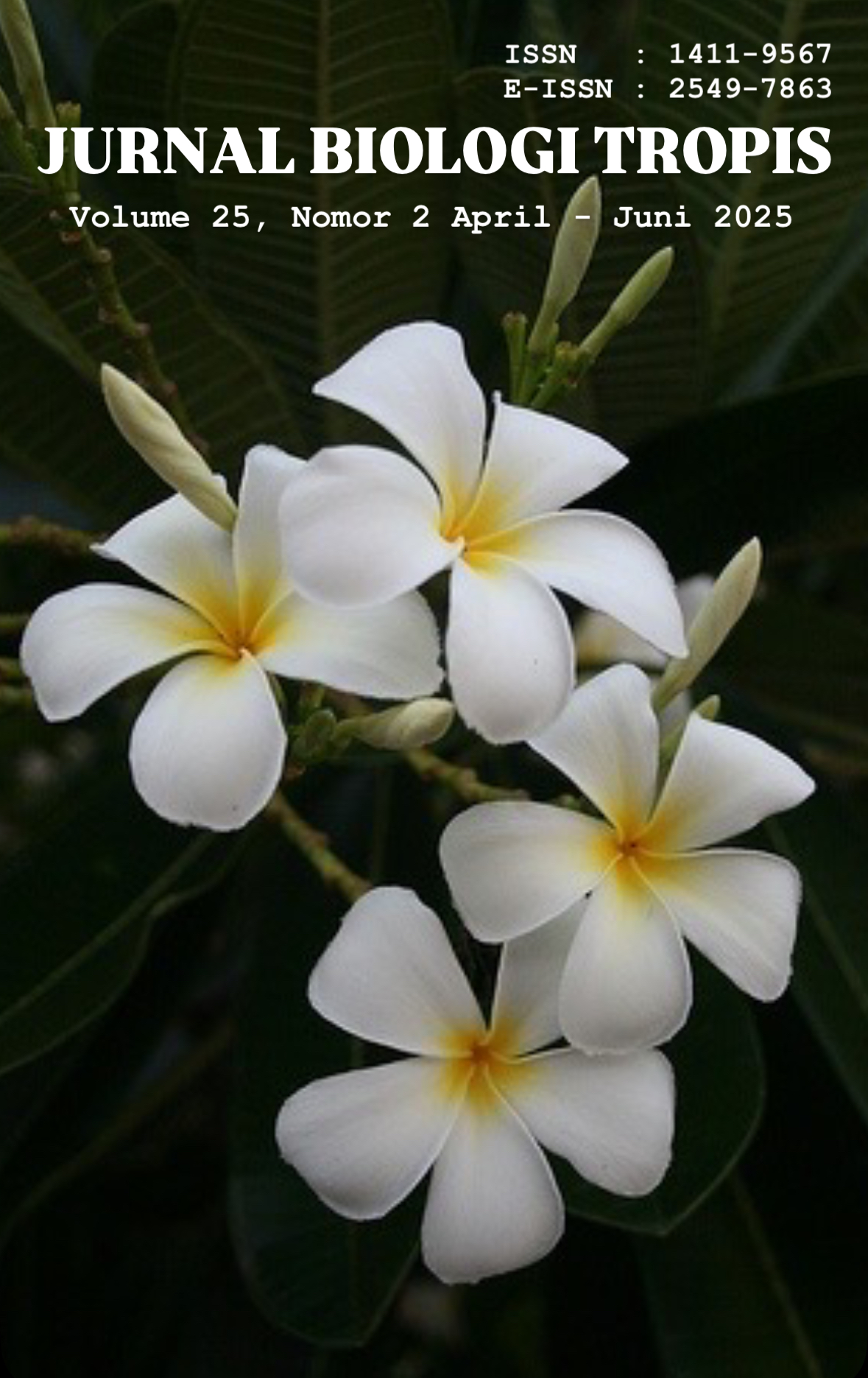Anatomy of Sarcotheca celebica’s vegetative organs growing in Morowali on Ultramafic and Limestone Soils
Authors
Wahyu Harso , Mustafid Rasyiid , Ramadanil Ramadanil , Umrah Umrah , Moh. IqbalDOI:
10.29303/jbt.v25i2.8626Published:
2025-04-21Issue:
Vol. 25 No. 2 (2025): April-JuniKeywords:
Anatomy, calcareous, Sarcotheca celebica, ultramafic.Articles
Downloads
How to Cite
Downloads
Metrics
Abstract
Sarcotheca celebica is an endemic Sulawesi plant capable of growing in ultramafic and calcareous soils. The anatomical structure of its vegetative organs plays a role in adaptation to extreme environments. This study aimed to compare the anatomy of leaves, stems and roots of S. celebica in both soil types. Microscopic preparations of leaves, stems and roots were made with the Free Hand Section method, documented using Optilab Viewer 2.2, and measured with Image Raster 3. Statistical analysis was conducted with the T-test. The results showed anatomical variations in response to soil conditions. S. celebica plants in calcareous soil had longer and wider stomata, but with lower density than those in ultramafic soils. In addition, leaf and cuticle thickness were higher in S. celebica plants on calcareous soils. However, the peridemis/floem ratio in stems and peridermis/endodermis in roots did not show significant differences. Overall, S. celebica leaves were more responsive to soil differences than stems and roots. This study is important for understanding the mechanisms of plant adaptation to extreme soil conditions and the implications for the sustainability of the species in its natural habitat.
References
Aldress, A. & Hafsi, A. (2020). Impact of Evaporation on Field Capacity during Water Drainage Redistribution in a Soil. Hydrological Process, 35(2):1-7. https://doi.org/10.1002/hyp.14028
Astuti, I. P., Sari, R., Susandarini, R. & Zuhro, F. (2018). Tulisan Pendek: Sarcotheca celebica Veldkamp; Persebaran di Sulawesi, Status Konservasi dan Kelangkaan. Journal Biologi Indonesia, 14(1):143-146.
Avila-Lovera, E. & Winter, K. (2024). Variation in Stem Bark Conductance to Water Vapor in Neotropical Plant Species. Frontiers in Forest and Global Change, 6: 1278803. https://doi.org/10.3389/ffgc.2023.1278803
Bontpart, T., Weiss, A., Vile, D., Gerad, F., Lacombe, B., Reichheld, J. P. & Mari, S. (2024). Trends in Plant Science, 29(12); 1319-1330. https://doi.org/10.1016/j.tplants.2024.03.013
Borkar, S. G., Reddy, P. & Chavan, V. A. (2023). Fungal Species Inhabiting Calcareous Soil in Western Maharashtra, India, and Their Role in the Release of Soil-Bonded Fe and Zn Micronutrient for Crop Plant Availability in Such Soils. World Journal of Advanced Research and Reviews, 20(03): 1622-1632. https://doi.org/10.30574/wjarr.2023.20.3.2626
Brearley, F. Q. (2024). Metal Hyperaccumulation in the Indonesia Flora. Ecological Research, 39: 957-965. DOI: 10.1111/1440-1703.12497
Dama, H., Aisyah, S.I., Sudarsono & Dewi, A.K. (2020). Respon Kerapatan Stomata dan Kandungan Klorofil Padi (Oryza sativa L.) Mutan terhadap Toleransi Kekeringan. Jurnal Ilmiah Aplikasi Isotop dan Radiasi, 16(1): 1-6.
Dumitrascu, M., Sarbu, A. & Cislariu, A. (2023). The Anatomical Structure of Symphotrichum squamatum, an Alien Plant In Romanian Flora. Acta Horti Botanici Bucurestiensis, 49: 5-16. https://doi.org/10.62229/ahbb491Z1Grd
Durand, M., Zhuang, X., Salmon, Y. & Robson, T. M. (2024). Caught between Two States: The Compromise in Acclimation of Photosynthesis, Transpiration and Mesophyll Conductance to Different Amplitudes of Fluctuating Irradiance. Plant, Cell & Environment. 1-17. DOI: 10.1111/pce.15107
Goodman, A. L., Underwood, G. M. & Grassian, V. H. (2000). A Laboratory Study of the Heterogeneous Reaction of Nitric Acid on Calcium Carbonate Particles. Journal of Geophysical Research, 105(23): 53-64.
Gou, L., Zhang, C., Lu, N. & Hu, S. (2023). A Soil Hydraulic Conductivity Equation Incorporating Adsorption and Capillarity. Journal of Geotechnical and Geoenvironmental Engineering, 149(8): 04023056. DOI: 10.1061/JGGEFK.GTENG-11388
Gricar, J., Zavadlav, S., Jyske, T., Lavric, M., Laakso, T., Hafner, P., Eler, K. & Vodnik, D. (2018). Effect of Soil Water Availability on Intra-Annual Xylem and Phloem Formation and Non-Structural Carbohydrate pools in Stem of Quercus pubescens. Tree Physiology, 39(2): 222-233. https://doi.org/10.1093/treephys/tpy101
Hasanuzzaman, Md., Zhou, M. & Shabala, S. (2023). How Does Stomatal Density and Residual Transpiration Contribute to Osmotic Stress Tolerance? Plants, 12, 294:1-19. https://doi.org/10.3390/plants12030494
Hepworth, C., Dohen-Adams, T., Hunt, L., Cameron, D. D. & Gray, J. E. (2015). Manipulating Stomatal Density Enhances Drougt Tolerance Without Deleterious Effect on Nutrient Uptake. New Phytologist, 208: 336-341. doi: 10.1111/nph.13598
Jaffre, T. (2022). Plant Mineral Nutrition on Ultramafic Rock of New Caledonia. Botany Letters, 170(1): 1-37. DOI:10.1080/23818107.2022.2080112
Jan, M., Mir, T. A., Khare, R. K. & Saini, N. (2022). Adaptation Strategies of Medicinal Plants in Response to Environmental Stresses. In: Environmental Challenges and Medicinal Plants. Environmental Challenges and Solution, Aftab, T. (Ed.) pp: 133-151. Springer Nature Switzerland. ISBN-10.3030920496
Kartawisastra, S., Anda, M. & Ritung, S. (2017). Pedoman Pengamatan Tanah di Lapangan. Badan Penelitian dan Pengembangan Pertanian. IAARD Press. Jakarta. ISBN 978-602-344-163-1
Liu, X., Wang, X., Zhu, J., Wang, X., Chen, K., Yuan, Y., Yang, X., Mo, W., Wang, R. & Zhang, S. (2024). Strong Conservatism in Leaf Anatomical Traits and Their Multidimensional Relationship with Leaf Economic Traits in Grasslands under Different Stressful Environments. Ecological Processes, 13: 13-71. https://doi.org/10.1186/s13717-024-00548-y
Monda, K., Mabuchi, A., Takahashi, S., Negi, J., Tohmori, R., Terashima, I., Yamori, W. & Iba, K. (2020). Increased Cuticle Permeability Caused by a New Allele of Acetyl-Coa Carboxylase1 Enhances CO2 Uptake. Plant Physiology, 184: 1917-1926.
Mozaffari, H., Moosavi, A. A. & Nematollahi, M. A. (2024). Predicting Saturated and Near-Saturated Hydraulic Conductivity Using Artificial Neural Networks and Multiple Linear Regression in Calcareous Soils. PLS One 19(1): 1-22. https://doi.org/10.1371/journal.pone.0296933
Nascimento, C. W. A., Lima, L. H. V., da Silva, J. A. B. & Biondi, C. M. (2022). Ultramafic soils and nickel phytomining opportunities: A review. Revista Brasileira de Ciencia do Solo. 46:e0210099. https://doi.org/10.36783/18069657rbcs20210099
Ristic, Z. & Jenks, M. (2002). Leaf Cuticle and Water Loss in Maize Lines Differing in Dehydration Avoidance. Journal of Plant Physiology, 156(6): 645-651. DOI:10.1078/0176-1617-0743
Soheili, F., Heydari, M., Woodward, S. & naji, H. R. (2023). Adaptive Mechanisms in Quercus brantii Lindl Leaves under Climatic Differentiation: Morphological and Anatomical Traits. Scientific Reports, 13: 3580. https://doi.org/10.1038/s41598-023-30762-1
Ullrich, W. (2024). Plant Anatomy for Sustainable Agriculture and Environmental Conservation. Journal of Botanical Sciences, 13(2): 13-14.
Valarmathi, R., Swamy, H. K. M., Appunu, C., Kambale, R. & Sudhagar, R. (2022). Anatomy of Tolerance Mechanisms in Sugarcane Crops to Abiotic Stress. In: Agro-Industrial Perspectives on Sugarcane Production under Environmental Stress, Verma, K, K., Song, X. P., Rajput, V. D., Solomon, S., Li, Y. R. & Rao, G. P. (Eds.), Springer Verlag, Singapore. pp 107-121. ISBN: 978-9811939549
Wang, C., Yuan, S. & Wang, H. (2024). The Impact of Water Storage Capacity on Plant Dynamic in Arid Environments: A Stoichiometric Modelling Approach. Mathematical Bioscience, 369. 109147: 1-10. https://doi.org/10.1016/j.mbs.2024.109147
Wang, J., Wen, X., Zang, X. & Li, S. (2018). The strategies of Water-Carbon Regulation of Plants in a Subtropical Primary Forest on Karst Soils in China. Biogeosciences, 15:4193-4203. https://doi.org/10.5194/bg-15-4193-2018
Yamauchi, T., Pedersen, O., Nakazono, M., & Tsutsumi, N. (2020). Key Roots Traits of Poaceae for Adaptation to Soil Water Gradients. New Phytologist, 229(6): 3133-3140. https://doi.org/10.1111/nph.17093
Yeung, E. C. (1998). A Beginner’s Guide to the Study of Plant Structure. In: Tested studies for Laboratory Teaching, Vol 19, S. J. Karcher, S. J. (Ed). Proceeding of the 19th Workshop/Conference of the Association for Biology Laboratory Education (ABLE). pp; 125-142. http://www.zoo.utoronto.ca/able/volumes/copyright.htm
License
Copyright (c) 2025 Wahyu Harso, Mustafid Rasyiid, Ramadanil Ramadanil, Umrah Umrah, Moh. Iqbal

This work is licensed under a Creative Commons Attribution 4.0 International License.

Jurnal Biologi Tropis is licensed under a Creative Commons Attribution 4.0 International License.
The copyright of the received article shall be assigned to the author as the owner of the paper. The intended copyright includes the right to publish the article in various forms (including reprints). The journal maintains the publishing rights to the published articles.
Authors are permitted to disseminate published articles by sharing the link/DOI of the article at the journal. Authors are allowed to use their articles for any legal purposes deemed necessary without written permission from the journal with an acknowledgment of initial publication to this journal.


























